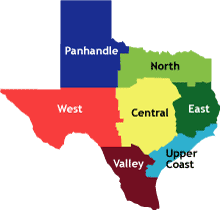Regional Highlights - Central Texas Issues

Click on your region for
more specific issues.
Game Wardens Arrest Men for Illegally Transporting Deer (Central)
On Oct. 16 in Mills County, Texas Parks and Wildlife Department game wardens apprehended two central Texas men and a resident of Louisiana for allegedly hauling eight whitetail deer believed to have been smuggled across state lines.
Texas game wardens have been receiving information for several years about whitetail deer being brought across state lines. This is not only illegal but also poses a disease threat to native whitetail deer. Texas borders essentially remain closed to the importation of whitetail and mule deer because of disease concerns.
This year, wardens focused on several regions of the state and spent many hours conducting surveillance of trucks towing stock trailers believed to be hauling deer. In cooperation with wildlife officers from several other states and U.S. Fish and Wildlife Service federal agents, Texas game wardens have made several similar cases this year. This one marks the largest in TPWD Region 7 in western Central Texas. (More information)
Prospects Looking Good for Deer Season (Central)
Hunters hoping for a shot at a quality deer during the 2008-09 deer season will need to get off the bench and into the game, suggest state wildlife biologists, as current range conditions indicate increased availability of native food sources.
The general deer hunting season opens statewide Nov. 1. This change in deer feeding patterns could also have an impact on opportunity around feeders during the Special Youth Season weekend Oct. 25-26. The youth-only season is available to licensed hunters ages 16 and under.
Central Texas Report:
Rainfall amounts throughout Central Texas have been below average since early last fall when the faucet was turned off after the exceptionally wet spring and summer of 2007, according to Mike Krueger, TPWD district biologist in Kerrville. Deer did not come through the winter in as good as nutritional condition as they would have with a wet winter, so they undoubtedly were not in optimum condition when bucks initiated antler growth last spring and does were entering the last stages of pregnancy.
"It continued to remain dry during the antler growing and fawn rearing period this summer and because of this, I expect fawn survival and recruitment will be below average," said Krueger. "Ditto with antler quality; I expect it to be below average and too late to salvage even though habitat conditions have improved somewhat in recent weeks."
Body conditions heading into the season are improving, thanks to an unexpected acorn crop.
"Nature is amazing in showing the ability to offset a set of poor conditions with a set of unexpectedly good conditions," Krueger noted. "A decent acorn crop can put some fat on deer this winter, but it would be too late to help improve this year’s fawn production or antler quality."
TPWD technical guidance biologist Mike Reagan in Wimberley had similar things to say about this season.
"I am seeing a lot of acorns on most ranches in my areas," Reagan reported. "A lot of them began falling in September, but there seems to still be some on the trees. It should make hunting a little tougher. I also think antler growth will be below normal, but I have seen excellent antlers on some mature bucks. Yes, the fawn crop is well below normal in the eastern half of the Edwards Plateau. In most of this country the fawn crop ranged from 10-30 percent, but on some well-managed ranches it was more like 40-60 percent."
In the western parts of the Hill Country, TPWD technical guidance biologist Joyce Moore in Harper had this to offer.
"The far western Hill Country counties fared much better through the drought as they had more summer rainfall," she said. "Exceptional fawn crops of 60-100 percent are the norm in Sutton and Schleicher counties. As you travel east from Junction, however, fawn crops declined to about 40-50 percent.
"Right now the acorns and a few recent showers are saving the deer herd, but I am telling my co-op folks that unless we get more rain, the winter will be very stressful," she pointed out. "I am hearing many reports of declining antler quality, except for the high-fence folks who are intensively feeding protein-they say their antler quality is much better than in 2007. They believe that a dry year actually causes the bucks to consume more protein feed rather than in a wet year when they would prefer native forage."
Last year was the second year of antler restrictions in all or portions of seven Edwards Plateau counties (eastern Comal, eastern Travis, eastern Hays, Williamson, Bell, Coryell, and Lampasas).
 Click here to add, change, or remove your subscription to this newsletter.
Click here to add, change, or remove your subscription to this newsletter.
Content of this site © Texas Parks and Wildlife Department unless otherwise noted.
Texas Parks and Wildlife Department
4200 Smith School Road, Austin, TX 78744